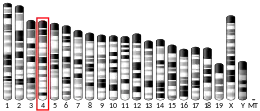Hippocalcin is a protein that in humans is encoded by the HPCA gene.[5][6]
Hippocalcin is a calcium-binding protein that belongs to the neuronal calcium sensor (NCS) family of proteins.[7][8] It is expressed in mammalian brains especially in the hippocampus. It possesses a Ca2+/myristoyl switch.[9]
Processes
Hippocalcin takes part in the following processes:
- Activation of PLD1 and PLD2 expression
- Inhibition of apoptosis
- MAP kinase signalling
- Involved in long term depression in hippocampal neuron
- Required for normal spatial learning
Interactions
Hippocalcin interacts with following proteins:
- Neuronal apoptosis inhibitory protein (NAIP)
- Mixed lineage kinase 2 (MLK2) – MLK2 is myosin light chain kinase 2
- The b2 adaptin of the AP2 complex
- Calcium-dependent activator protein for secretion (CADPS)
References
- 1 2 3 GRCh38: Ensembl release 89: ENSG00000121905 - Ensembl, May 2017
- 1 2 3 GRCm38: Ensembl release 89: ENSMUSG00000028785 - Ensembl, May 2017
- ↑ "Human PubMed Reference:". National Center for Biotechnology Information, U.S. National Library of Medicine.
- ↑ "Mouse PubMed Reference:". National Center for Biotechnology Information, U.S. National Library of Medicine.
- ↑ Takamatsu K, Kobayashi M, Saitoh S, Fujishiro M, Noguchi T (April 1994). "Molecular cloning of human hippocalcin cDNA and chromosomal mapping of its gene". Biochem. Biophys. Res. Commun. 200 (1): 606–11. doi:10.1006/bbrc.1994.1491. PMID 8166736.
- ↑ Masaki T, Sakai E, Furuta Y, Kobayashi M, Takamatsu K (December 1998). "Genomic structure and chromosomal mapping of the human and mouse hippocalcin genes". Gene. 225 (1–2): 117–24. doi:10.1016/S0378-1119(98)00526-5. PMID 9931466.
- ↑ Burgoyne RD (2007). "Neuronal Calcium Sensor Proteins: Generating Diversity in Neuronal Ca2+ Signalling". Nat. Rev. Neurosci. 8 (3): 182–193. doi:10.1038/nrn2093. PMC 1887812. PMID 17311005.
- ↑ Burgoyne RD, O'Callaghan DW, Hasdemir B, Haynes LP, Tepikin AV (2004). "Neuronal Ca2+-sensor proteins: multitalented regulators of neuronal function". Trends Neurosci. 27 (4): 203–9. doi:10.1016/j.tins.2004.01.010. PMID 15046879. S2CID 24156457.
- ↑ O'Callaghan DW, Tepikin AV, Burgoyne RD (2003). "Dynamics and calcium sensitivity of the Ca2+/myristoyl switch protein hippocalcin in living cells". J. Cell Biol. 163 (4): 715–721. doi:10.1083/jcb.200306042. PMC 2173692. PMID 14638856.
Further reading
- Hidaka H, Okazaki K (1993). "Neurocalcin family: a novel calcium-binding protein abundant in bovine central nervous system". Neurosci. Res. 16 (2): 73–7. doi:10.1016/0168-0102(93)90074-Z. PMID 8387172. S2CID 4210072.
- Nagao M, Hayashi H (2009). "Mixed lineage kinase 2 and hippocalcin are localized in Lewy bodies of Parkinson's disease". J. Neurol. Sci. 281 (1–2): 51–4. doi:10.1016/j.jns.2009.02.375. PMID 19332348. S2CID 13177773.
- Kobayashi M, Takamatsu K, Saitoh S, et al. (1992). "Molecular cloning of hippocalcin, a novel calcium-binding protein of the recoverin family exclusively expressed in hippocampus". Biochem. Biophys. Res. Commun. 189 (1): 511–7. doi:10.1016/0006-291X(92)91587-G. PMID 1280427.
- Nagata K, Puls A, Futter C, et al. (1998). "The MAP kinase kinase kinase MLK2 co-localizes with activated JNK along microtubules and associates with kinesin superfamily motor KIF3". EMBO J. 17 (1): 149–58. doi:10.1093/emboj/17.1.149. PMC 1170366. PMID 9427749.
- Kobayashi M, Takamatsu K, Saitoh S, Noguchi T (1993). "Myristoylation of hippocalcin is linked to its calcium-dependent membrane association properties". J. Biol. Chem. 268 (25): 18898–904. doi:10.1016/S0021-9258(17)46711-1. PMID 8360179.
- Rudinskiy N, Kaneko YA, Beesen AA, et al. (2009). "Diminished hippocalcin expression in Huntington's disease brain does not account for increased striatal neuron vulnerability as assessed in primary neurons". J. Neurochem. 111 (2): 460–72. doi:10.1111/j.1471-4159.2009.06344.x. PMID 19686238.
- Gerhard DS, Wagner L, Feingold EA, et al. (2004). "The Status, Quality, and Expansion of the NIH Full-Length cDNA Project: The Mammalian Gene Collection (MGC)". Genome Res. 14 (10B): 2121–7. doi:10.1101/gr.2596504. PMC 528928. PMID 15489334.
- Strausberg RL, Feingold EA, Grouse LH, et al. (2002). "Generation and initial analysis of more than 15,000 full-length human and mouse cDNA sequences". Proc. Natl. Acad. Sci. U.S.A. 99 (26): 16899–903. Bibcode:2002PNAS...9916899M. doi:10.1073/pnas.242603899. PMC 139241. PMID 12477932.
- Mercer EA, Korhonen L, Skoglösa Y, et al. (2000). "NAIP interacts with hippocalcin and protects neurons against calcium-induced cell death through caspase-3-dependent and -independent pathways". EMBO J. 19 (14): 3597–607. doi:10.1093/emboj/19.14.3597. PMC 313967. PMID 10899114.
- Ivings L, Pennington SR, Jenkins R, et al. (2002). "Identification of Ca2+-dependent binding partners for the neuronal calcium sensor protein neurocalcin delta: interaction with actin, clathrin and tubulin". Biochem. J. 363 (Pt 3): 599–608. doi:10.1042/0264-6021:3630599. PMC 1222513. PMID 11964161.
- O'Callaghan DW, Haynes LP, Burgoyne RD (2005). "High-affinity interaction of the N-terminal myristoylation motif of the neuronal calcium sensor protein hippocalcin with phosphatidylinositol 4,5-bisphosphate". Biochem. J. 391 (Pt 2): 231–8. doi:10.1042/BJ20051001. PMC 1276920. PMID 16053445.
- O'Callaghan DW, Ivings L, Weiss JL, et al. (2002). "Differential use of myristoyl groups on neuronal calcium sensor proteins as a determinant of spatio-temporal aspects of Ca2+ signal transduction". J. Biol. Chem. 277 (16): 14227–37. doi:10.1074/jbc.M111750200. PMID 11836243.
- Markova 0, Fitzgerald D, Stepanyuk A; et al. (2009). "Hippocalcin signaling via site-specific translocation in hippocampal neurons". Neurosci. Lett. 442 (2): 152–7. doi:10.1016/j.neulet.2008.06.089. PMC 2572729. PMID 18634855.
{{cite journal}}: CS1 maint: multiple names: authors list (link) CS1 maint: numeric names: authors list (link)
External links
This article is issued from Wikipedia. The text is licensed under Creative Commons - Attribution - Sharealike. Additional terms may apply for the media files.



